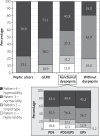Assessment of gastric acidity by short-duration intragastric pH-monitoring with standardised breakfast in functional and some other dyspepsias
- PMID: 33005273
- PMCID: PMC7509895
- DOI: 10.5114/pg.2020.99041
Assessment of gastric acidity by short-duration intragastric pH-monitoring with standardised breakfast in functional and some other dyspepsias
Abstract
Introduction: Preliminary assessment of gastric secretion in the treatment of organic and functional dyspepsia may offer advantages over the empirical administration of proton pump inhibitors suggested by most clinical guidelines.
Aim: To develop a simplified pH-metric test with standardised meal, and on its basis to perform an assessment of the functional state of gastric secretion in the most common dyspepsias.
Material and methods: Serum pepsinogen 1 and 2 were used for reference. Intragastric pH-monitoring was performed during 45 min in basal phase and 135 min after provocative breakfast (507 kcal, 100 mg caffeine). Consecutive adults enrolled in the study were divided into groups: 1 - "Non-dyspeptic" - 30 persons; 2 - "Duodenal peptic ulcer" - 13; 3 - "GERD" - 82; and 4 - "Functional dyspepsia" - 125 patients.
Results: There was a moderate association between concentration of pepsinogen-1 and parameters of pH-monitoring. The best correlation coefficients were for the nadir pH in basal conditions and the time of acid neutralisation > 3.5 after the meal - r = -0.534 and r = -0.541, respectively (p < 0.0001). Using these two parameters we considered discriminants for four patterns of acidity. Proposed criteria of Hipo-anacidity included an absence of active secretion of hydrochloric acid in basal (pHmin > 5) and postprandial phases, with the achievement of stable pH < 3.5 after 80 min from meal time. They showed sensitivity 88.9% and specificity 100%. In cases of a detected pattern of hyperacidity, these parameters were 80% and 66.67%, respectively. According to the prevalence of hyperacidic cases, the groups were ranked in the following order: duodenal ulcer (76.9%) - GERD (51.1%) - functional dyspepsia (40.8%) - non-dyspeptic (19.0%).
Conclusions: Acid production is increased among patients with functional dyspepsia. There is a small number of patients with functional dyspepsia (12.1%) with hypochlorhydria due to atrophic gastritis. The latter was independently associated with age > 50 years (OR = 20.139), symptoms of postprandial distress-syndrome (OR = 9.821), and signs of atrophy (OR = 5.914) after conventional endoscopy.
Keywords: atrophic gastritis; dyspepsia; intragastric pH-metry; pepsinogens.
Copyright © 2020 Termedia.
Conflict of interest statement
The author declares no conflict of interest.
Figures


Similar articles
-
Prevalence of acidic and non-acidic refluxes in patients with functional dyspepsia and its risk factors investigated by means of multichannel intraluminal pH-monitoring.Wiad Lek. 2019;72(4):604-612. Wiad Lek. 2019. PMID: 31055541
-
Patterns of 24 h intragastric acidity in duodenal ulcers in children: the importance of monitoring and inhibiting nocturnal acidity.Acta Paediatr Jpn. 1995 Oct;37(5):557-61. doi: 10.1111/j.1442-200x.1995.tb03377.x. Acta Paediatr Jpn. 1995. PMID: 8533579
-
[A comparative assessment of gastric secretory function using a probe method and intragastric Ph-metry].Klin Med (Mosk). 1990 Mar;68(3):89-92. Klin Med (Mosk). 1990. PMID: 2370764 Russian.
-
24-h recording of intragastric pH: technical aspects and clinical relevance.Scand J Gastroenterol Suppl. 1999;230:9-16. Scand J Gastroenterol Suppl. 1999. PMID: 10499456 Review.
-
Cholecystokinin in the control of gastric acid and plasma gastrin and somatostatin secretion in healthy subjects and duodenal ulcer patients before and after eradication of Helicobacter pylori.J Physiol Pharmacol. 1994 Dec;45(4 Suppl 1):3-66. J Physiol Pharmacol. 1994. PMID: 7787215 Review.
Cited by
-
Helicobacter pylori infection and hypochlorhydria in Zambian adults and children: A secondary data analysis.PLoS One. 2021 Aug 27;16(8):e0256487. doi: 10.1371/journal.pone.0256487. eCollection 2021. PLoS One. 2021. PMID: 34449790 Free PMC article.
References
-
- Ghosh T, Lewis DI, Axon ATR, Everett SM. Review article: methods of measuring gastric acid secretion. Aliment Pharmacol Ther 2011; 33: 768-81. - PubMed
-
- Talley NJ, Vakil N, Moayyedi P. American Gastroenterological Association technical review on the evaluation of dyspepsia. Gastroenterology 2005; 129: 1756-80. - PubMed
-
- Benberin V, Bektayeva R, Karabayeva R, et al. . Prevalence of H. pylori infection and atrophic gastritis among symptomatic and dyspeptic adults in Kazakhstan. A hospital-based screening study using a panel of serum biomarkers. Anticancer Res 2013; 33: 4595-602. - PubMed
-
- Roman LD, Lukyanchuk R, Sablin OA, et al. . Prevalence of H. pylori infection and atrophic gastritis in a population-based screening with serum biomarker panel (GastroPanel®) in St. Petersburg. Anticancer Res 2016; 36: 4129-38. - PubMed
LinkOut - more resources
Full Text Sources
